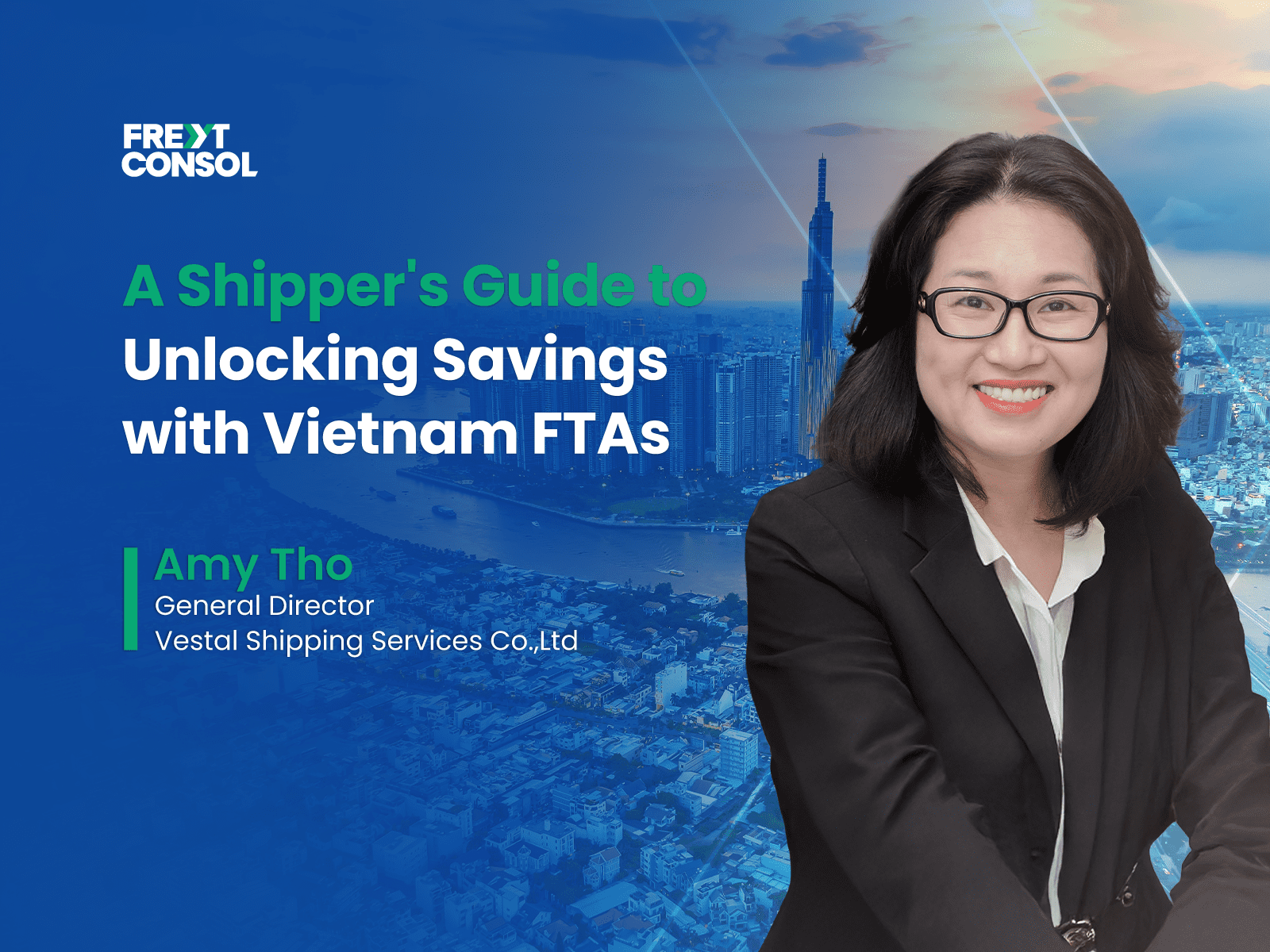By Amy Tho, General Director of Vestal Shipping Services Co., Ltd.

In the complex, fast-paced world of global trade, staying competitive means capitalizing on every available advantage. For businesses importing from or exporting to Vietnam, one of the most significant, yet often underutilized, advantages lies within its extensive network of Free Trade Agreements (FTAs). Vietnam has strategically positioned itself as a global manufacturing and trading powerhouse by signing numerous bilateral and multilateral trade pacts. These agreements do more than just lower tariffs; they create streamlined pathways for goods, reduce non-tariff barriers, and offer unprecedented access to key markets across the globe.
However, navigating the intricate rules, dense legal texts, and specific documentation of these FTAs can be daunting. A simple oversight can negate all potential savings and lead to costly delays. Understanding which agreement applies to your shipment, how to prove your goods qualify, and how to avoid common pitfalls is critical for unlocking cost savings and ensuring smooth, predictable customs clearance. This is where deep, local expertise becomes not just a benefit, but a necessity.
The Power of Trade Pacts for Your Cargo
Free Trade Agreements are treaties between two or more countries designed to reduce or eliminate barriers to trade and investment. For the logistics and freight forwarding industry, their impact is profound. They influence everything from landed costs and transit times to long-term supply chain strategies. By making trade more efficient and less expensive, FTAs directly boost the flow of goods that companies like Freyt Consol members manage every day.
“Vietnam’s active participation in major FTAs is a clear signal to the world that we are open for business,” states Amy Tho, a trade compliance expert with Vestal Shipping Services in Ho Chi Minh City. “For our clients, these agreements translate into tangible benefits. It’s not just about paying lower import duties; it’s about gaining a competitive edge through improved market access, simplified customs procedures, and a more predictable trading environment. This is especially crucial for LCL consolidation, where efficiency and cost-effectiveness are paramount.”
Vietnam's commitment to economic integration has resulted in a robust portfolio of FTAs, connecting it with over 60 markets worldwide, including major economic blocs in Asia, Europe, and the Americas.
A Deeper Dive into Vietnam's Key Trade Pacts
While Vietnam is a party to over a dozen FTAs, three stand out for their sheer scope and impact on global supply chains. Understanding the specific opportunities within each is key to leveraging them effectively.
The EU-Vietnam FTA (EVFTA)
Effective since August 2020, the EVFTA is one of the most ambitious trade deals ever concluded between the EU and a developing country. It is on track to eliminate nearly 99% of all customs duties. For shippers, this opens a massive, high-value market. For example, Vietnamese furniture and textile exporters gain a significant price advantage in the EU, while EU-based machinery and automotive parts manufacturers can supply Vietnam's industrial sector more cheaply.
“The EVFTA has been a game-changer, but the devil is in the details,” Amy Tho explains. “To benefit, exporters in the EU now use the Registered Exporter (REX) system to self-certify the origin of their goods on a commercial document. Vietnamese exporters must obtain a Certificate of Origin, Form EUR.1. We guide clients through this process daily to ensure their documentation is flawless, preventing any hold-ups at customs in Hamburg or Ho Chi Minh City.”
The CPTPP
The Comprehensive and Progressive Agreement for Trans-Pacific Partnership (CPTPP) connects Vietnam with 10 other countries across the Asia-Pacific and the Americas, including major markets like Japan, Canada, Australia, and Mexico. This pact is a supply chain strategist's dream, as it allows for "cumulation of origin." This means materials sourced from any member country can be used in production without disqualifying the final product from receiving preferential tariff rates.
Consider a Vietnamese company manufacturing high-performance athletic wear. Under the CPTPP, they can import specialized synthetic fabrics from Japan, assemble the garments in Vietnam, and export the finished product to Canada, all while benefiting from reduced tariffs at each stage, provided the rules of origin are met.
“The CPTPP encourages building sophisticated regional supply chains,” Amy notes. “It rewards businesses that can orchestrate multi-country production. This level of flexibility is a massive advantage for building resilient and cost-effective operations.”
The RCEP
The Regional Comprehensive Economic Partnership (RCEP) is the world's largest trade bloc, encompassing 15 Asia-Pacific nations that collectively account for about 30% of global GDP. This agreement, which includes China, Japan, South Korea, Australia, New Zealand, and all 10 ASEAN states, is primarily focused on creating a unified market within Asia by harmonizing many existing agreements.
RCEP simplifies trade within the region by establishing a common set of rules of origin and streamlining customs procedures. For a company assembling electronics in Vietnam, this is huge. They can now source components from China, semiconductors from South Korea, and plastic casings from Malaysia under a single, coherent ruleset, making compliance far simpler and more predictable when exporting the final product to Australia.
Common Pitfalls and How to Avoid Them
The financial rewards of using FTAs are significant, but so are the risks of getting it wrong. A rejected claim for preferential duty can lead to unexpected costs, shipment delays, and even fines.
- 1. Misunderstanding Rules of Origin (ROO): This is the most common error. A product doesn't qualify just because it was shipped from an FTA partner country. It must "originate" there. This is often proven through "Substantial Transformation," meaning the product underwent a significant manufacturing process. Simply repackaging Chinese goods in Vietnam, for instance, will not qualify them for FTA benefits.
- 2. Critical Documentation Errors: The Certificate of Origin (C/O) is a legal document where precision is absolute. A simple typo, an incorrect HS code, a missing signature, or a date format that doesn’t match the commercial invoice can be grounds for rejection by customs authorities.
- 3. Violating Transshipment Rules: To qualify for FTA benefits, goods must typically be shipped directly from the exporting member country to the importing member country. If the cargo is transshipped through a non-member country (e.g., Singapore or Hong Kong), you must provide evidence that the goods remained under customs control and did not undergo any processing.
“We’ve seen businesses lose thousands of dollars in potential duty savings because of a simple paperwork mistake or a misunderstanding of transit rules,” warns Amy Tho. “These aren’t just administrative hurdles; they are strict legal requirements. Proactive compliance is the only way to guarantee you secure the benefits and avoid penalties.”
A Practical Checklist for FTA Compliance
To successfully leverage Vietnam’s FTAs, a methodical approach is essential.
- ‣ Step 1: Strategic Product & Market Analysis: Before you even think about shipping, confirm that your specific product (via its HS code) is covered by the FTA in your target market and what the preferential duty rate will be.
- ‣ Step 2: Meticulous HS Code Classification: The entire process hinges on the correct Harmonized System (HS) code. This code determines the tariff rate and the specific rule of origin your product must meet. Double-check and verify it.
- ‣ Step 3: Master the Rules of Origin: Obtain the text of the FTA and find the specific rule of origin for your product's HS code. Ensure your production process and material sourcing comply fully.
- ‣ Step 4: Flawless Documentation: Prepare your Certificate of Origin and all supporting commercial documents with extreme care. Ensure every detail aligns perfectly across all paperwork.
- ‣ Step 5: Partner with a Local Expert: The complexities are best handled by a partner on the ground. A knowledgeable freight forwarder like Vestal Shipping Services can manage this entire process, from document vetting to customs liaison, turning regulatory burdens into a seamless part of your logistics.
The Future of Trade: What's Next for Vietnam?
Vietnam’s commitment to open trade is unwavering. The country is actively working on digitalizing its customs processes to make trade even faster and more transparent. Furthermore, Vietnam continues to explore new trade agreements, including potential pacts with other economic blocs. Future agreements will likely place an even greater emphasis on sustainability and labor standards, integrating environmental and social governance (ESG) into the fabric of trade policy. For businesses, this means that staying informed and adaptable will be key to long-term success in this dynamic market.

Article written by
Freyt Consol is a global network for LCL consolidators and NVOCCs dedicated to excellence and long-term growth. We create an environment where members thrive by collaborating with trusted partners and accessing essential resources.




